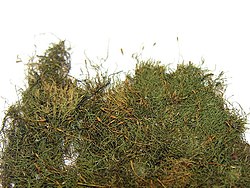| Amblystegium serpens | |
|---|---|
 | |
| Scientific classification | |
| Kingdom: | Plantae |
| Division: | Bryophyta |
| Class: | Bryopsida |
| Subclass: | Bryidae |
| Order: | Hypnales |
| Family: | Amblystegiaceae |
| Genus: | Amblystegium |
| Species: | A. serpens |
| Binomial name | |
| Amblystegium serpens Schimp. | |
Amblystegium serpens, also known as the creeping feathermoss or nano moss, [1] is a species of moss. It is a common species in Britain.
The species is pleurocarpous in form, with ovate to lanceolate leaves which end in a fine acute point. It forms creeping mats on decaying tree stumps, hedgebanks and other shaded sites.
It can live under water, and is used as a plant in some home aquariums.